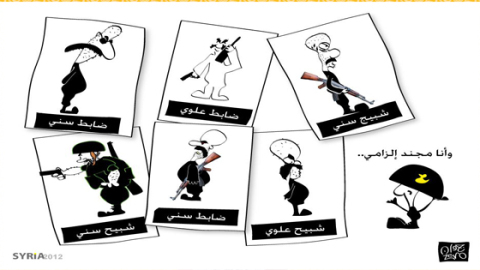“One, one, one. The Syrian people are one.” This motto, used by Syrian protesters throughout the country since very early in the uprising, points at the widespread awareness that sectarianism is the greatest danger facing the uprising. For 40 years, the ruling Assad family worked on portraying itself as the guarantor of Syrian ethnic, cultural and religious diversity, and used the threat of sectarianism as a weapon to criminalize all opposition. Michel Kilo and Riad Seif, who attempted to bring to the fore a debate on the status of Syria’s multi-ethnic and multi-confessional society, were persecuted and jailed under the fluffy accusations of “inciting sectarian unrest”.
The uprising began with the lofty ideals and calls for democracy and ending tyranny. The response came quick and swift from the regime by simultaneously inciting sectarian feuds, and publicly warning of the destructive force of a sectarian war. This amounted to very thinly veiled threats of unleashing such a war.

A war soon began between civil activists trying to calm the already simmering sectarian tensions in society, and the regime that was cynically exploiting them as a bargaining chip. Rumors coupled with choreographed instigations in loyalist areas were the regime’s main tools in its quest. Activists resisted through outreach efforts across communities through joint protests, and joint funerals. Their efforts materialized themselves in that lofty chant heard in almost all demonstrations in the early months of the uprising: “One, one, one. The Syrian people are united as one.”
The first sectarian flagrations, however, soon erupted in the mixed coastal regions of the country. Nedal Jannoud, an Alawite, was murdered in the city of Banias. The regime accused opposition’s Sunni extremists of killing him, while activists and opposition figures maintained that he was killed by the regime precisely to instigate sectarian tensions in the region.
The murder of Jannoud outraged Alawites in the region and threatened a serious conflict between the two communities. Activists responded by reaching out, and holding direct talks with local Alawi dignitaries in the aim of calming the situation. These local agreements to preserve civic peace pushed the regime even further in its attempt to bring Alawites on its side. A concerted and cynical media campaign on regime-controlled television stations ensued. This campaign, along with others, emphasized strongly the historical sense of victimization Alawites had developed after long centuries of religious and political oppression under the Ottomans.
Homs was the second city after Banias where sectarian tensions came to the fore. The town, also a home to a many different sects, was the first major urban center to fully embrace the uprising in its early days. Sectarian tensions flared in the town after a series of kidnappings, instigated at first by regime forces, that developed dangerously quickly to envelope the whole town in a sense of dread and isolating its different communities completely from each other.
https://www.youtube.com/watch?v=c9CsO2H3GwU
Activists again tried to counter this by bringing people from the different communities together through protests and debate circles, as well putting a concerted effort to raise awareness, within the opposition crowd, of the dangers of responding to the regime’s sectarian discourse.
Several groups were established in the city with the specific aim of promoting coexistence and preventing further civil strife. Nabd (“pulse” in English), was one of the more active of these groups. Its members, themselves from different religious backgrounds, used several methods to bring isolated communities together. “We used to bring activists from different communities to opposition areas, and facilitate their participation in demonstrations. We would also help and encourage these activists to attend funerals to show support for their compatriots,” recounts one member of the group.
The activists also successfully recruited several high profile personalities from artists, poets and writers to participate in their events and promote peaceful coexistence. The most famous example is that of Fadwa Suleiman, a well-known artist who frequently went to Homs to promote the uprising’s civil and nonviolent components.
Nevertheless, as the regime became more brutal in its oppression and more weapons poured into the country, militarist attitudes began to take root. These attitudes formed a hospitable environment for sectarian discourses, especially after the arrival of radical Islamist groups like al-Nusra Front and the Islamic State in Iraq and Syria (ISIS).
The activists campaigns, while significantly curtailed by these developments, have not died down, and neither has their will and motivation. With the arrival of jihadist groups, however, civil society activists find themselves increasingly under threat from both the regime and militias associated with al-Qaeda. Nevertheless, the driving force behind these movements, today as yesterday, is their sense of ownership towards Syria’s uprising, and their dedication to reclaiming it from the hands of old and new forms of tyranny.



